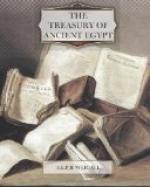It is curiously interesting to notice how general is the present belief in the solemnity of this ancient race’s attitude towards existence, and how little their real character is appreciated. Already the reader will be protesting, perhaps, that the application of the geographer’s summary of French characteristics to the ancient Egyptians lessens in no wise its ridiculousness, but rather increases it. Let the protest, however, be held back for a while. Even if the Egyptians were not always frivolous, they were always uncommonly gay, and any slight exaggeration will be pardoned in view of the fact that old prejudices have to be violently overturned, and the stigma of melancholy and ponderous sobriety torn from the national name. It would be a matter of little surprise to some good persons if the products of excavation in the Nile Valley consisted largely of antique black kid gloves.
[Illustration: PL. VIII. Two Egyptian
boys decked with flowers and a
third
holding a musical instrument. They are
standing
against the outside wall of the
Dendereh
Temple.]
[Photo by E. Bird.
Like many other nations the ancient Egyptians rendered mortuary service to their ancestors, and solid tomb-chapels had to be constructed in honour of the more important dead. Both for the purpose of preserving the mummy intact, and also in order to keep the ceremonies going for as long a period of time as possible, these chapels were constructed in a most substantial manner, and many of them have withstood successfully the siege of the years. The dwelling-houses, on the other hand, were seldom delivered from father to son; but, as in modern Egypt, each grandee built a palace for himself, designed to last for a lifetime only, and hardly one of these mansions still exists even as a ruin.
Moreover the tombs were constructed in the dry desert or in the solid hillside, whereas the dwelling-houses were situated on the damp earth, where they had little chance of remaining undemolished. And so it is that the main part of our knowledge of the Egyptians is derived from a study of their tombs and mortuary temples. How false would be our estimate of the character of a modern nation were we to glean our information solely from its churchyard inscriptions! We should know absolutely nothing of the frivolous side of the life of those whose bare bones lie beneath the gloomy declaration of their Christian virtues. It will be realised how sincere was the light-heartedness of the Egyptians when it is remembered that almost everything in the following record of their gaieties is derived from a study of the tombs, and of objects found therein.




